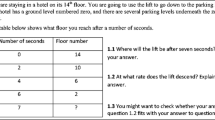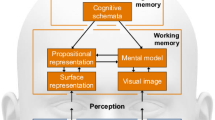Abstract
Recent research on the phenomenon of improper proportional reasoning focused on students’ understanding of elementary functions and their external representations. So far, the role of basic function properties in students’ concept images of functions remained unclear. We add to this research line by investigating how accurate students are in connecting functions to their corresponding properties and how this accuracy depends on function types and representations. A large group of 10th graders evaluated for different function types, represented in either a graphical, a formulaic, or a tabular mode, the correctness of statements about their general properties and behavior. Results show that students succeeded rather well in making the right connections between properties and functions. Errors depended not only on the type of function for which the properties were evaluated but also on the kind of representation in which the function was presented. These results highlight the importance of function properties in students’ concept images of functions and suggest positive effects of making these properties explicit to students.

Similar content being viewed by others
Notes
In the Anglo-Saxon literature, an “y = ax + b” model is denoted as a “linear” model (etymologically derived from the Latin word linea which stands for (straight) line, the graphical representation of a linear function). In this paper, we follow this arrangement, but we differentiate between cases in which b = 0 and b ≠ 0, respectively, denoted by the terms “proportional” and “affine.” Affine models with a = 1 are denoted as “additive.” In line with these definitions, the “overuse of proportionality” (i.e. the overuse of an “y = ax” model) is a specific utterance the “overuse of linearity” (i.e. the overuse of an “y = ax + b” model).
In the rest of this paper, we will use the term “representation” to denote “external representation.”
The increasing affine and proportional function could not be involved in these comparisons because almost all students assigned statement MD2 correctly to these two function types.
References
Acevedo Nistal, A., Van Dooren, W., Clarebout, G., Elen, J. & Verschaffel, L. (2010). Representational flexibility in linear-function problems: a choice/no-choice study. In L. Verschaffel, E. De Corte, T. de Jong & J. Elen (Eds.), Use of representations in reasoning and problem solving: analysis and improvement (New perspectives on learning and instruction series) (pp. 74–93). Oxon, UK: Routledge.
Acevedo Nistal, A., Van Dooren, W. & Verschaffel, L. (2012). What counts as a flexible representational choice? an evaluation of students’ representational choices to solve linear function problems. Instructional Science, 40(6), 999–1019.
Adu-Gyamfi, K. & Bossé, M. J. (2014). Processes and reasoning in representations of linear functions. International Journal of Science and Mathematics Education, 12, 167–192.
Adu-Gyamfi, K., Stiff, L. V. & Bossé, M. J. (2012). Lost in translation: Examining translation errors associated with mathematical representation. School Science and Mathematics, 112(3), 159–170.
Berté, A. (Ed.). (1987). Enseignement des mathématiques utilisant la ‘réalité’: Tome 1 (2 nde éd, 1992) [Teaching mathematics using ‘reality’: Part 1 (2nd ed., 1992]. Bordeaux, France: IREM.
Berté, A. (1993). Mathématique dynamique [Dynamical mathematics]. Paris, France : Nathan.
Centre de Recherche sur l’Enseignement des Mathématiques (2002). Des grandeurs aux espaces vectoriels: La linéarité comme fil conducteur [From quantities to vector spaces: Linearity as a general guiding principle]. Nivelles, Belgium : Author.
De Bock, D., Verschaffel, L. & Janssens, D. (1998). The predominance of the linear model in secondary school students’ solutions of word problems involving length and area of similar plane figures. Educational Studies in Mathematics, 35, 65–83.
De Bock, D., Van Dooren, W., Janssens, D. & Verschaffel, L. (2007). The illusion of linearity: from analysis to improvement (mathematics education library). New York, NY: Springer.
De Bock, D., Van Dooren, W. & Verschaffel, L. (2015). Students’ understanding of proportional, inverse proportional, and affine functions: two studies on the role of external representations. International Journal of Science and Mathematics Education, 13(Suppl. 1), 47–69.
Freudenthal, H. (1983). Didactical phenomenology of mathematical structures. Dordrecht, Netherlands: Reidel.
Gagatsis, A. & Kyriakides, L. (2000). Teachers’ attitudes towards their pupils’ mathematical errors. Educational Research and Evaluation, 6, 24–58.
Hart, K. (1988). Ratio and proportion. In J. Hiebert & M. Behr (Eds.), Number concepts and operations in the middle grades (pp. 198–219). Reston, VA: National Council of Teachers of Mathematics.
Kaput, J. J. & West, M. M. (1994). Missing-value proportional reasoning problems: Factors affecting informal reasoning patterns. In G. Harel & J. Confrey (Eds.), The development of multiplicative reasoning in the learning of mathematics (pp. 235–287). New York, NY: State University of New York Press.
Karplus, R. (1979). Continuous functions: Students’ viewpoints. European Journal of Science Education, 1, 397–413.
Lanius, C. S. & Williams, S. E. (2003). Proportionality: A unifying theme for the middle grades. Mathematics Teaching in the Middle School, 8(8), 392–396.
Leinhardt, G., Zaslavsky, O. & Stein, M. K. (1990). Functions, graphs, and graphing: Tasks, learning, and teaching. Review of Educational Research, 60, 1–64.
Lesh, R., Post, T. & Behr, M. (1988). Proportional reasoning. In J. Hiebert & M. Behr (Eds.), Number concepts and operations in the middle grades (pp. 93–118). Reston, VA: National Council of Teachers of Mathematics.
Liang, K.-Y. & Zeger, S. L. (1986). Longitudinal data analysis using generalized linear models. Biometrika, 73, 13–22.
Markovits, Z., Eylon, B.-S. & Bruckheimer, M. (1986). Functions today and yesterday. For the Learning of Mathematics, 6(2), 18–24. 28.
Matz, M. (1982). Towards a process model for high school algebra errors. In D. Sleeman & J. S. Brown (Eds.), Intelligent tutoring systems (pp. 25–50). London, UK: Academic.
Noelting, G. (1980). The development of proportional reasoning and the ratio concept. Part I: Differentiation of stages. Educational Studies in Mathematics, 11, 217–253.
Tall, D. & Vinner, S. (1981). Concept image and concept definition in mathematics with particular reference to limits and continuity. Educational Studies in Mathematics, 12, 151–169.
Thomas, M. O. J. (2008). Developing versatility in mathematical thinking. Mediterranean Journal for Research in Mathematics Education, 7(2), 71–91.
Van Dooren, W. & Greer, B. (Eds.) (2010). Special issue: Dominance of linearity in mathematical thinking. Mathematical Thinking and Learning, 12, 1–115.
Van Dooren, W., De Bock, D., Depaepe, F., Janssens, D. & Verschaffel, L. (2003). The illusion of linearity: expanding the evidence towards probabilistic reasoning. Educational Studies in Mathematics, 53, 113–138.
Van Dooren, W., De Bock, D., Hessels, A., Janssens, D. & Verschaffel, L. (2005). Not everything is proportional: effects of age and problem type on propensities for overgeneralization. Cognition and Instruction, 23(1), 57–86.
Van Dooren, W., De Bock, D., Janssens, D. & Verschaffel, L. (2008). The linear imperative. An inventory and conceptual analysis of students’ overuse of linearity. Journal for Research in Mathematics Education, 39(3), 311–342.
Van Dooren, W., De Bock, D. & Verschaffel, L. (2012). How students understand aspects of linearity: searching for obstacles in representational flexibility. In T.-Y. Tso (Ed.), Proceedings of the 36th conference of the international group for the psychology of mathematics education (Vol. 4, pp. 179–186). Taipei, Taiwan: PME.
Van Dooren, W., De Bock, D. & Verschaffel, L. (2013). How students connect descriptions of real-world situations to mathematical models in different representational modes. In G. Stillman, G. Kaiser, W. Blum & J. Brown (Eds.), Teaching mathematical modelling: connecting to research and practice (international perspectives on the teaching and learning of mathematical modelling series) (pp. 385–393). New-York, NY: Springer.
Vergnaud, G. (1983). Multiplicative structures. In R. Lesh & M. Landau (Eds.), Acquisition of mathematics concepts and processes (pp. 127–174). New York, NY: Academic.
Author information
Authors and Affiliations
Corresponding author
Rights and permissions
About this article
Cite this article
De Bock, D., Neyens, D. & Van Dooren, W. Students’ Ability to Connect Function Properties to Different Types of Elementary Functions: An Empirical Study on the Role of External Representations. Int J of Sci and Math Educ 15, 939–955 (2017). https://doi.org/10.1007/s10763-016-9724-z
Received:
Accepted:
Published:
Issue Date:
DOI: https://doi.org/10.1007/s10763-016-9724-z




